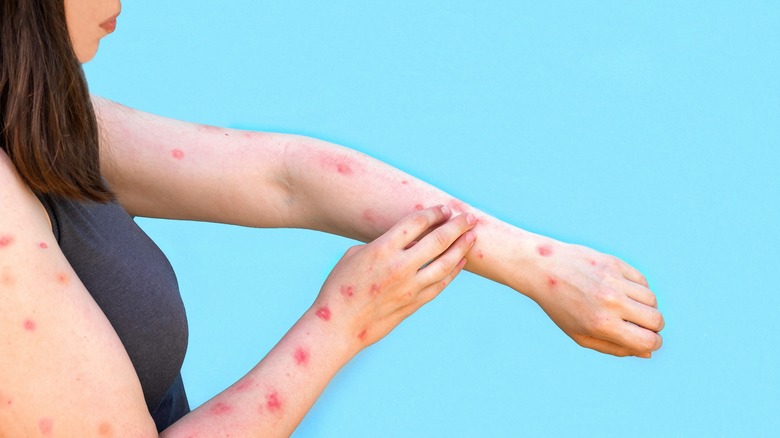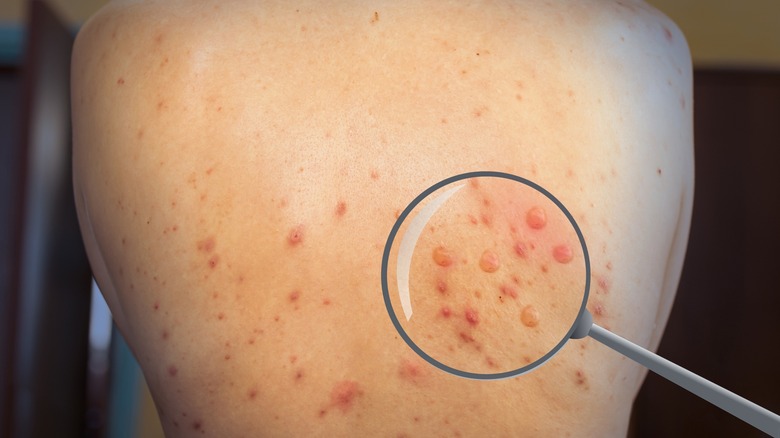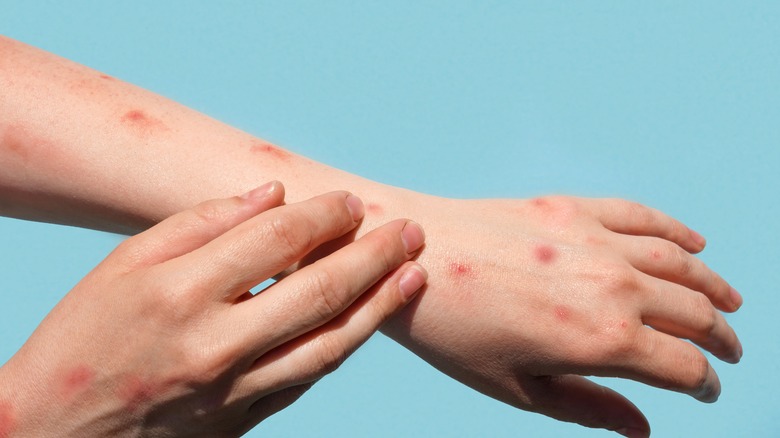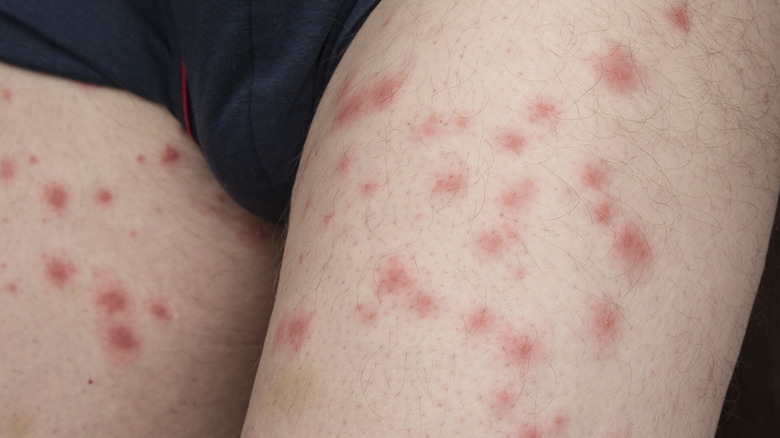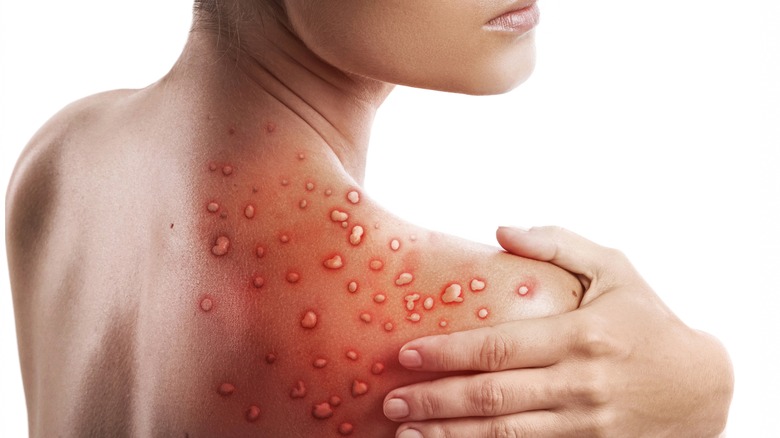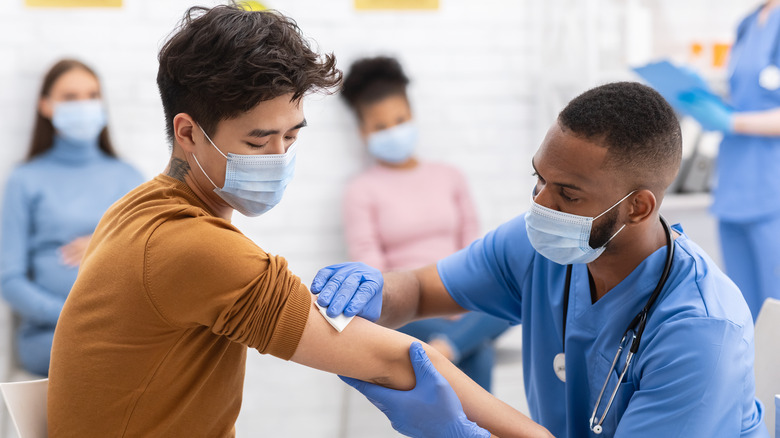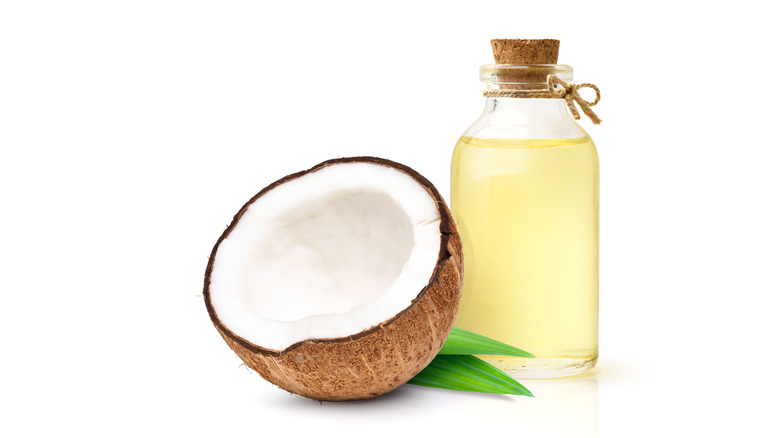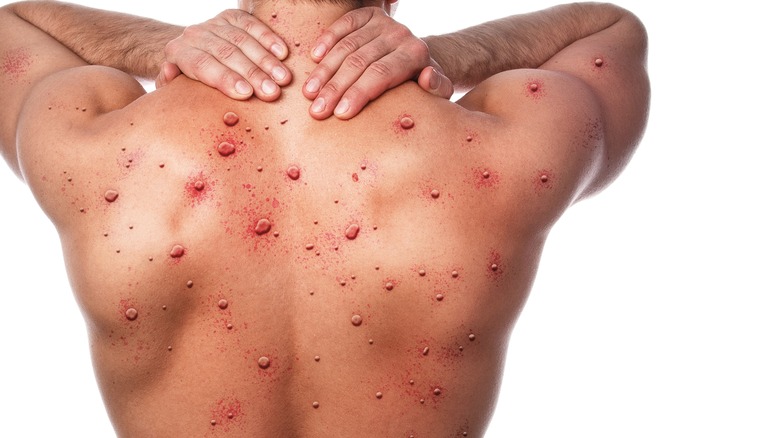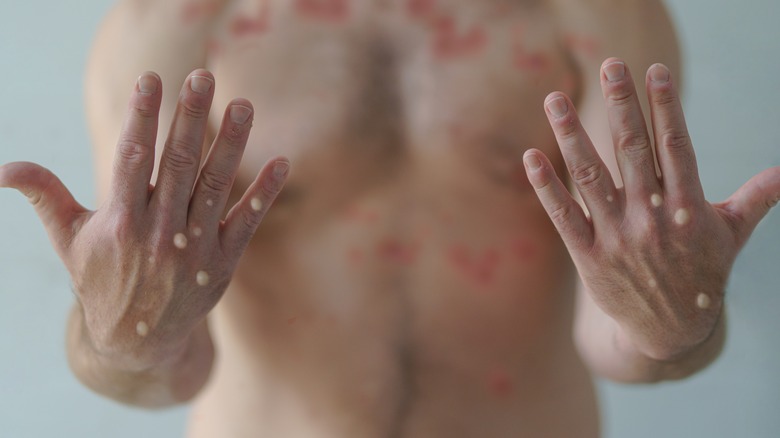Red Spots Explained: Causes, Symptoms, And Treatments
Red spots on the skin are quite common and they often occur almost anywhere on your body like your neck, chest, the topmost part of your back, and face due to various health issues, including allergies (per Healthline). Conditions as mild as heat rashes — caused by extended exposure to heat — may bring about spots on your skin and the problem may go away after a short period without you seeking medical intervention, states the National Health Service. However, more serious infections (meningitis, rubella, and chickenpox, for instance) may also cause red pimples along with other severe symptoms that may threaten your health if you don't receive treatment (via Medical News Today).
Blau syndrome — a rare health condition that features red skin spots along with uvea (the centermost layer of your eye) inflammation and arthritis symptoms — may also be the reason you're observing red dots on your skin (per the Genetic and Rare Diseases Information Center). And without the proper understanding of the illness, how to differentiate it from other conditions that cause red skin spots, other symptoms to look out for to narrow down to the most likely health problem (if you don't have Blau syndrome), reliable treatment options, and when to seek immediate medical attention for serious cases, it's easy to lose money, time and effort on the wrong things.
That's why we're providing you with the information you need on red spots to help you know how best to handle them.
Popular causes
Red spots on the skin come about due to several reasons including the build-up of dead skin cells, hair follicles, and oil in your skin. This occurrence leads to acne bumps. Medical experts also suggest that a virus can cause red spots which signal the condition known as pityriasis rosea (via the Universal Dermatology & Vein Care). The National Health Service explains that this condition is often characterized by the herald patch — a red oval-shaped patch of skin that appears dry and flaky, which comes a few days before a rash outbreak on your body.
The patch presents itself on your neck, stomach, back, or chest — although, at times, it may be visible around your private parts, scalp, or face. When the rash outbreak happens, the itchy rashes keep growing and spreading throughout your body for the next 14 to 42 days. When the rashes go away, you're left with areas of your body that appear lighter or darker than your natural skin tone.
Universal Dermatology & Vein Care also explains that yeasts that exist in your body may also cause fungal infections like tinea versicolor that may cause red bumps on your skin. Moreover, the yeasts, together with bacteria and fungi can also pave the way for inflammation in your hair follicles, which may cause tiny red spots on your lower backside, legs, chin, arms, and back — a condition called folliculitis. Plus, when some people take certain medications or their body reacts to specific medication, or they get infections, their small blood vessels called capillaries may get destroyed — leading to blood getting into their skin and forming blood spots.
Types of red spots on the skin
Different health conditions bring about red spots that vary in shape, size, texture, and redness. For example, in allergic reactions, there are times when clear fluid may get into the spots, and other times, they may look crusty. When the reactions become severe, it's not a surprise to have blisters or swelling, reports Allure. In keratosis pilaris — where keratin (a protein that forms part of your skin, nails, and hair) remains in your hair follicles' perforations, the red posts that form are usually coarse-textured and bumpy.
And when it comes to eczema, which is also referred to as atopic dermatitis, the look and feel of the red spots are completely different from those in keratosis pilaris and allergic reactions. Speaking in an interview with Allure, Dr. Andrea Suarez, a board-certified dermatologist based in Texas said, "Atopic dermatitis appears as red patches or spots of inflamed skin, though in deeper skin tones, the affected areas may have more of a purple to gray hue."
Health Grades also adds that a bacterial infection called strep throat may lead to scarlet fever that features patchy red rashes which initially begins as flat but later on grow to become bumpy, with the texture that resembles sandpaper. In the case of vasculitis — where you get inflamed blood vessel walls, you may get spots that look like those of scarlet fever. Sometimes, the spots may present themselves as red purplish lumps due to the pooled blood below your skin.
Red spots from insect bites
The National Health Service points out that the common insects that leave red spots include hornets, bees, mosquitoes, ticks, horseflies, midges, bedbugs, mites, fleas, spiders, ants, ladybirds, flower-bugs, and caterpillars. When a hornet stings you, it brings an itchy feeling and swelling to the affected area, which may last several days. The sting may also cause a severe allergic reaction for some people that may further increase the swelling on the mouth and face, and even make breathing a hectic process.
Mosquitoes, too, leave tiny lumps on your skin that may get you scratching the bitten part for a while. The area may even end up forming blisters. With tick bites, the affected area may not be painful, however, you may notice bruises, swelling, a tiny red lump, blisters, or itchiness, that may make you realize that you've actually gotten a bite.
When horseflies bite, they not only leave a massive rash — often referred to as a hive — but also leave you swollen, feeling feeble, and dizzy. Medical News Today mentions sand flies as other additional insects that give you red spots. Sand flies cause faded blisters and bumps on your skin which may be itchy and painful. In some extreme cases, ulcers may appear. And it's easy for these flies to pass on health conditions such as the heartland virus (a condition that makes you have a fever and a sickly feeling that resembles flu) and leishmaniasis (a condition that brings about skin sores).
Red spots and viral infections
Viral infections such as measles, roseola, mumps, chickenpox, and rubella may also get your body covered with red pimples (per Health Grades). The Centers for Disease Control and Prevention notes that, in measles, a rash is among the initial symptoms. Red spots start forming around your hairline and then they trickle down to your neck, arm, and even legs. Tiny elevated bumps may come up on the red spots and the spots may eventually connect to form widespread redness all over your body. With roseola, it begins with a fever — although not always — and as the fever begins dying away, you notice several flat red spots on your chest, stomach, and back — and afterward, your face, arms, neck, and legs (via the Mayo Clinic).
The Cleveland Clinic explains that mumps bring about swelling on each side of your face, where the parotid glands (glands that help with saliva production) are located. Chickenpox covers your whole body with itchy red spots that contain fluids, and that, at times, look like blisters. There are essentially three stages with chickenpox: An increase in red-pinkish elevated bumps on your skin, the formation of blisters that, later on, rupture and leak out the fluid in the blisters, and then the formation of scabs and crusts on top of the blisters (per another article on the Mayo Clinic).
Risk factors
When it comes to the risk factors for red spots, it's important to note that skin-affecting conditions have varying risk factors. This means that your chances of developing a condition that will give you red spots depend on the risk factors for that particular condition. For instance, your odds of developing folliculitis are higher if your facial hair is curly or have ingrown hair, if you visit poorly maintained hot tubs, if you like clothes consisting of material that absorbs and keeps heat for long periods, if you're a person with acne or eczema, or if you have conditions that target the immune system like diabetes or chronic lymphocytic leukemia, or if waxing and other hair elimination methods affect your skin (via Healthline).
WebMD points out that in rubella (also called the "German measles"), people are at an increased risk of getting the condition if they come in contact with the virus that causes it, especially if they haven't received the condition's vaccination. Healthline also explains that people who are likely to get eczema are those who have a relative with seasonal allergies or asthma. And with hives, if you interact with triggers that cause hives — like insects, pollen, heat, medications, certain foods, latex, and cold — you stand a chance of getting the condition.
Common symptoms that often accompany red spots
Blau syndrome — a disorder that's highlighted by inflammation in different body parts including eyes, joints, skin, liver, brain, heart, blood vessels, spleen, lungs, and lymph nodes, which causes rashes on the skin — often brings about fevers, nerve issues and high pressure in your lungs' blood vessels as well as the heart's. And while the manifestation of the symptoms differs with every individual, they keep evolving as the condition advances. In the initial stages, a rash may be visible on your legs, torso, and arms and it may be firm, or dry and flaky. From there, joint problems and eye disease follow. Other common symptoms include reduced joint movements, joint pain, inflammation in the cornea, and darkening and uneven color of your skin (per Medical News Today).
In the case of rosacea, you may observe facial redness that may stay for long and resemble sunburn. Moreover, some tiny but very firm red bumps containing pus may appear. You may also get a burning sensation. Plus, you may start seeing tiny blood vessels on your skin (via the Cleveland Clinic). The Mayo Clinic mentions that, in measles, the red spots may come together with a runny nose, eye inflammation, dry cough, fever, sore throat, and small spots that appear whitish — whose middle part appear bluish on the inner side of your cheek. According to Drugs.com, common symptoms that get dragged along with rashes are swelling in the lymph nodes and fever. In anaphylaxis — a dangerous type of allergic reaction, the visible symptoms may be unconsciousness, vomiting, confusion, hives, breathing problems, low blood pressure, and cramps.
Assessing red spots
When you notice rashes on your skin and can't tell the cause, you may decide to seek medical attention. Among the first steps your doctor will take to figure out what's happening is to evaluate the rashes you have to determine the condition you're having and the best treatment method for you. According to Dr. Jonathan Bowling, three main steps involved in rash investigation exist: Asking varying questions that paint a better picture of your health history, assessing the rash, and then performing tests for confirmation.
Common questions asked include when you first noticed the rash, any accompanying symptoms you have, if you always feel like scratching it, and if there's been any spread to other body parts. Your doctor may also want to know any recent medications you've had, if your family members had a similar case in the past, if insects have bitten you, and if you've interacted with anything you're normally not used to.
MedlinePlus explains you may do several tests depending on your medical information and the signs and symptoms you're having. For instance, to figure out if it's allergic contact dermatitis, you'll get a dry patch test that will help reveal if you're having allergic reactions. The doctor will put several tiny patches on different areas of your body that can react to different allergic triggers. You then spend two to four days with the patches after which your doctor takes them off to see if there's any evidence of reactions. Biopsies (which involve a tiny skin sample for proper analysis) and blood tests may also be part of your evaluation.
Medication
Red spots are easily treatable through medication and skin care products. For instance, you can tone down the negative effects of eczema through moisturizers made of mineral oils, glycerin, and ceramides. The moisturizers shouldn't have any fragrances. Over-the-counter (OTC) creams such as Neosporin Eczema, Dermarest Eczema, and Cortizone-10 that have hydrocortisone — a common ingredient known to handle rashes, eczema, allergies, and dermatitis — may also come in handy for the eczema symptoms you may be having.
In extreme cases, the go-to medication may be cortisone shots and pills, or prescription-strength cortisone creams. In lichen planus (a skin problem characterized by flat, gleaming bumps with a purple and red color combination), antihistamines like diphenhydramine, can help stop the itching. Moreover, prednisone and steroid shots that regulate your immune system may be part of your treatment if the condition intensifies (per WebMD).
While medication generally helps to deal with red spots, there are certain types of medical drugs that may also induce rashes, according to Johns Hopkins Medicine. The type of rashes that result from your body reacting to the medication you're taking is popularly referred to as drug rashes, and they may affect you mildly or severely in one of three ways: By heightening your responsiveness to sunlight, inducing allergic reactions, or bringing nasty side effects after taking the medication.
Common types of rashes that spring from medication include hives (which come from taking penicillins, aspirin, and various medicine dyes), acne (which come from taking corticosteroids, iodides, and bromides), Stevens-Johnson syndrome (which come from penicillins, sulfa, and barbiturates), and exfoliative dermatitis (which come from penicillins, sulfa, phenytoin, and isoniazid).
Home remedies
Some of the items you use at home may also help do away with red spots. According to the Laser & Dermatology Institute of California, if you have acne, squeezing lemon juice from lemon, soaking a piece of cotton pad in the lemon juice and then rubbing it on the affected area, can help reduce the red spots as well as brown spots. Plant enzymes also have a disintegrating effect on melanin and can help clear up your skin.
Some of the options to consider in this category include a combination of honey and a grated potato, the paste of chickpeas boiled to mushiness, pineapple juice, and a mask made from mashed papaya. Aloe vera gel is also another effective intervention. When rubbed softly on the affected area and left for about half an hour before washing it off with water, it can get rid of the spots and rejuvenate your skin, if you use it for several weeks. Moreover, dandelion root, coconut oil, and cocoa butter are great considerations too.
When it comes to cocoa butter, Dr. Joshua Zeichner — a New York City-based dermatologist who's board-certified — told StyleCraze, "It is a potent antioxidant that reduces inflammation and also has emollient benefits to hydrate and soften cells in the outer skin layer." There are biologically active compounds in cocoa butter that help do away with the redness and inflammation in red spots. Dandelion root, on the other hand, has the ability to reduce inflammation that minimizes red skin spots.
Common complications with red spots
Per Health Grades, the long-term implications of various conditions that cause red skin spots are mostly easy to manage. However, in some cases, life-threatening effects may also come about. Eczema doesn't have a cure but the negative effects it brings can be easily tamed. For most people, the condition appears and disappears over their lifespan. When you get bitten or stung by insects and get skin spots, you need not worry as these don't have long-term effects. They only bring about a bit of swelling and discomfort that goes away with time. In scarlet fever, many people don't suffer extended effects. Nonetheless, if they do come, they can be as fatal as getting rheumatic fever (an inflammatory condition that springs from untreated scarlet fever or strep throat) and kidney injury. The good thing is, antibiotics can make the negative effects less likely to occur.
For viral infections including chickenpox and measles, some of the known complications are meningitis, pneumonia, and birth defects. Vaccination is the best prevention against viral infections despite the ability to recuperate after you get it. The most likely complications you may face with cutaneous vasculitis are often dependent on the reasons why you got the condition in the first place. In some cases, extreme complications like having your organs destroyed, losing your eyesight, and blood clots may occur (via the Mayo Clinic). Also, your doctor may require you to have medication throughout your lifetime to manage it (via Health Grades).
Prevention
StyleCraze explains that you can prevent an outbreak of red spots on your skin by reducing the frequency of times you bask in the sun. This keeps you from getting a condition called polymorphous light eruption, sun poisoning, or sun allergy, which may occur if you're highly sensitive to sunlight. It's common in people who stay out in the sun a lot during spring and summer. After getting it for the first time, it reoccurs every year after that (per the Mayo Clinic). Also, StyleCraze adds that you'll need to stop using products that consist of unpleasantly rough chemicals that hurt your skin.
Some of these chemicals mentioned by WebMD include phenoxyethanol, parabens, methylchloroisothiazolinone, imidazolidinyl urea, DMDM hydantoin, Quaternium-15, and alpha-hydroxy acids. Other than ditching the chemicals, you should also change your diet to a more healthy one that provides a moderate amount of proteins, carbs, and vitamins. Moreover, you should get into the regular practice of face exfoliation (via StyleCraze). Nemours Kids Health also advises you to keep a distance from those who have rashes that can get passed from one person to another through physical contact — and stop interacting with substances that bring you allergic reactions.

